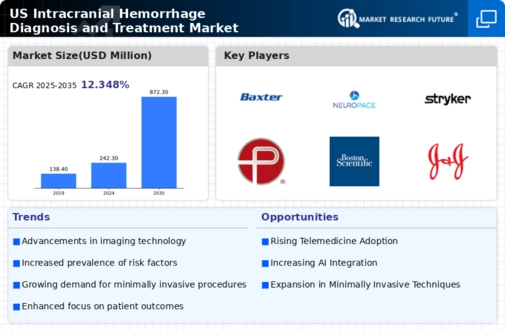Rising Geriatric Population
The increasing geriatric population in the US is a crucial driver of the intracranial hemorrhage-diagnosis-and-treatment market. Older adults are at a higher risk for conditions that lead to intracranial hemorrhage, such as hypertension and anticoagulant use. The US Census Bureau projects that by 2030, approximately 20% of the population will be aged 65 and older. This demographic shift is expected to result in a higher incidence of intracranial hemorrhage cases, thereby increasing the demand for diagnostic and treatment services. Healthcare providers are likely to focus on developing tailored solutions to address the unique needs of this population, further stimulating market growth.
Government Initiatives and Funding
Government initiatives and funding aimed at improving healthcare infrastructure are playing a pivotal role in the intracranial hemorrhage-diagnosis-and-treatment market. Programs designed to enhance access to advanced diagnostic tools and treatment options are being implemented across various states. For instance, the National Institutes of Health has allocated substantial funding for research into better diagnostic methods and treatment protocols for intracranial hemorrhage. Such investments are expected to foster innovation and improve patient care standards. As these initiatives gain traction, they are likely to stimulate market growth by increasing the availability of resources and technologies necessary for effective diagnosis and treatment.
Advancements in Surgical Techniques
Innovations in surgical techniques are transforming the landscape of the intracranial hemorrhage-diagnosis-and-treatment market. Minimally invasive procedures, such as endovascular coiling and craniotomy, are becoming more prevalent, offering patients reduced recovery times and lower complication rates. According to recent data, the adoption of these advanced techniques has increased by approximately 30% in the last few years. This shift not only enhances patient safety but also expands the range of treatment options available to healthcare providers. As surgical technology continues to evolve, the market is likely to experience significant growth, driven by the demand for effective and less invasive treatment modalities.
Increasing Awareness of Neurological Disorders
The growing awareness of neurological disorders, particularly intracranial hemorrhage, is driving the intracranial hemorrhage-diagnosis-and-treatment market. Educational campaigns and initiatives by healthcare organizations are enhancing public knowledge about symptoms and risk factors associated with intracranial hemorrhage. This heightened awareness is likely to lead to earlier diagnosis and treatment, potentially improving patient outcomes. In the US, the National Institute of Neurological Disorders and Stroke has reported that timely intervention can reduce mortality rates significantly. As more individuals recognize the signs of intracranial hemorrhage, the demand for diagnostic tools and treatment options is expected to rise, thereby propelling the market forward.
Integration of Artificial Intelligence in Diagnostics
The integration of artificial intelligence (AI) in diagnostic processes is emerging as a transformative factor in the intracranial hemorrhage-diagnosis-and-treatment market. AI algorithms are being developed to analyze imaging data more accurately and swiftly, potentially reducing the time to diagnosis. Recent studies indicate that AI can improve diagnostic accuracy by up to 20%, which is particularly critical in emergency settings. As healthcare facilities increasingly adopt AI technologies, the efficiency and effectiveness of diagnosing intracranial hemorrhage are likely to improve. This trend may lead to a surge in demand for AI-driven diagnostic tools, thereby enhancing the overall market landscape.

















Leave a Comment